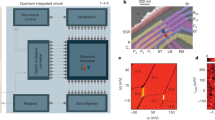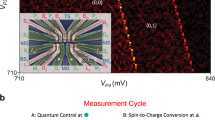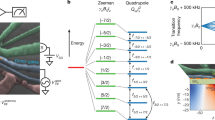Abstract
Single nuclear spins in the solid state are a potential future platform for quantum computing1,2,3, because they possess long coherence times4,5,6 and offer excellent controllability7. Measurements can be performed via localized electrons, such as those in single atom dopants8,9 or crystal defects10,11,12. However, establishing long-range interactions between multiple dopants or defects is challenging13,14. Conversely, in lithographically defined quantum dots, tunable interdot electron tunnelling allows direct coupling of electron spin-based qubits in neighbouring dots15,16,17,18,19,20. Moreover, the compatibility with semiconductor fabrication techniques21 may allow for scaling to large numbers of qubits in the future. Unfortunately, hyperfine interactions are typically too weak to address single nuclei. Here we show that for electrons in silicon metal–oxide–semiconductor quantum dots the hyperfine interaction is sufficient to initialize, read out and control single 29Si nuclear spins. This approach combines the long coherence times of nuclear spins with the flexibility and scalability of quantum dot systems. We demonstrate high-fidelity projective readout and control of the nuclear spin qubit, as well as entanglement between the nuclear and electron spins. Crucially, we find that both the nuclear spin and electron spin retain their coherence while moving the electron between quantum dots. Hence we envision long-range nuclear–nuclear entanglement via electron shuttling3. Our results establish nuclear spins in quantum dots as a powerful new resource for quantum processing.
This is a preview of subscription content, access via your institution
Access options
Access Nature and 54 other Nature Portfolio journals
Get Nature+, our best-value online-access subscription
$29.99 / 30 days
cancel any time
Subscribe to this journal
Receive 12 print issues and online access
$259.00 per year
only $21.58 per issue
Buy this article
- Purchase on Springer Link
- Instant access to full article PDF
Prices may be subject to local taxes which are calculated during checkout




Similar content being viewed by others
Data availability
The data that support the plots within this paper and other findings of this study are available from the corresponding authors upon reasonable request.
References
Kane, B. E. A silicon-based nuclear spin quantum computer. Nature 393, 133–137 (1998).
Ladd, T. D. et al. All-silicon quantum computer. Phys. Rev. Lett. 89, 017901 (2002).
Skinner, A. J., Davenport, M. E. & Kane, B. E. Hydrogenic spin quantum computing in silicon: a digital approach. Phys. Rev. Lett. 90, 087901 (2003).
Maurer, P. C. et al. Room-temperature quantum bit memory exceeding one second. Science 336, 1283–1286 (2012).
Saeedi, K. et al. Room-temperature quantum bit storage exceeding 39 minutes using ionized donors in silicon-28. Science 342, 830–833 (2013).
Muhonen, J. T. et al. Storing quantum information for 30 seconds in a nanoelectronic device. Nat. Nanotechnol. 9, 986–991 (2014).
Vandersypen, L. M. K. & Chuang, I. L. NMR techniques for quantum control and computation. Rev. Mod. Phys. 76, 1037–1069 (2005).
Pla, J. J. et al. High-fidelity readout and control of a nuclear spin qubit in silicon. Nature 496, 334–338 (2013).
Pla, J. J. et al. Coherent control of a single 29Si nuclear spin qubit. Phys. Rev. Lett. 113, 246801 (2014).
Childress, L. et al. Coherent dynamics of coupled electron and nuclear spin qubits in diamond. Science 314, 281–285 (2006).
Neumann, P. et al. Single-shot readout of a single nuclear spin. Science 329, 542–544 (2010).
Abobeih, M. H. et al. One-second coherence for a single electron spin coupled to a multi-qubit nuclear-spin environment. Nat. Commun. 9, 2552 (2018).
Bernien, H. et al. Heralded entanglement between solid-state qubits separated by three metres. Nature 497, 86–90 (2013).
Tosi, G. et al. Silicon quantum processor with robust long-distance qubit couplings. Nat. Commun. 8, 450 (2017).
Nowack, K. C. et al. Single-shot correlations and two-qubit gate of solid-state spins. Science 333, 1269–1272 (2011).
Veldhorst, M. et al. An addressable quantum dot qubit with fault-tolerant control-fidelity. Nat. Nanotechnol. 9, 981–985 (2014).
Veldhorst, M. et al. A two-qubit logic gate in silicon. Nature 526, 410–414 (2015).
Watson, T. F. et al. A programmable two-qubit quantum processor in silicon. Nature 555, 633–637 (2018).
Zajac, D. M. et al. Resonantly driven CNOT gate for electron spins. Science 359, 439–442 (2018).
Huang, W. et al. Fidelity benchmarks for two-qubit gates in silicon. Nature 569, 532–536 (2019).
Maurand, R. et al. A CMOS silicon spin qubit. Nat. Commun. 7, 13575 (2016).
Johnson, A. C. et al. Triplet–singlet spin relaxation via nuclei in a double quantum dot. Nature 435, 925–928 (2005).
Chekhovich, E. A. et al. Nuclear spin effects in semiconductor quantum dots. Nat. Mater. 12, 494–504 (2013).
Yang, C. H. et al. Spin-valley lifetimes in a silicon quantum dot with tunable valley splitting. Nat. Commun. 4, 2069 (2013).
Assali, L. V. C. et al. Hyperfine interactions in silicon quantum dots. Phys. Rev. B 83, 165301 (2011).
Elzerman, J. M. et al. Single-shot read-out of an individual electron spin in a quantum dot. Nature 430, 431–435 (2004).
Dehollain, J. P. et al. Bell’s inequality violation with spins in silicon. Nat. Nanotechnol. 11, 242–246 (2016).
Wolfowicz, G. et al. 29Si nuclear spins as a resource for donor spin qubits in silicon. New J. Phys. 18, 023021 (2016).
Pica, G., Lovett, B. W., Bhatt, R. N., Schenkel, T. & Lyon, S. A. Surface code architecture for donors and dots in silicon with imprecise and nonuniform qubit couplings. Phys. Rev. B 93, 035306 (2016).
Harvey-Collard, P. et al. Coherent coupling between a quantum dot and a donor in silicon. Nat. Commun. 8, 1029 (2017).
Fujita, T., Baart, T. A., Reichl, C., Wegscheider, W. & Vandersypen, L. M. K. Coherent shuttle of electron-spin states. Npj Quantum Inf. 3, 22 (2017).
Freer, S. et al. A single-atom quantum memory in silicon. Quantum Sci. Technol. 2, 015009 (2017).
Mi, X. et al. A coherent spin–photon interface in silicon. Nature 555, 599–603 (2018).
Samkharadze, N. et al. Strong spin–photon coupling in silicon. Science 359, 1123–1127 (2018).
Bennett, C. H. et al. Purification of noisy entanglement and faithful teleportation via noisy channels. Phys. Rev. Lett. 76, 722–725 (1996).
Nickerson, N. H., Li, Y. & Benjamin, S. C. Topological quantum computing with a very noisy network and local error rates approaching one percent. Nat. Commun. 4, 1756 (2013).
Mazzocchi, V. et al. 99.992% 28Si CVD-grown epilayer on 300 mm substrates for large scale integration of silicon spin qubits. J. Cryst. Growth 509, 1–7 (2019).
Donkelaar, J. Van et al. Single atom devices by ion implantation. J. Phys. Condens. Matter 27, 154204 (2015).
Davies, J. H. The Physics of Low-dimensional Semiconductors: An Introduction (Cambridge Univ. Press, 1997).
Acknowledgements
We thank C. Escott, P. Harvey-Collard, V. V. Dobrovitski for valuable discussions and feedback on the manuscript, and J. J. Pla for technical assistance. We acknowledge support from the US Army Research Office (W911NF-17-1-0198), the Australian Research Council (CE170100012), Silicon Quantum Computing Proprietary Limited and the NSW Node of the Australian National Fabrication Facility. The views and conclusions contained in this document are those of the authors and should not be interpreted as representing the official policies, either expressed or implied, of the Army Research Office or the US Government. B.H. acknowledges support from the Netherlands Organisation for Scientific Research (NWO) through a Rubicon Grant. K.M.I. acknowledges support from a Grant-in-Aid for Scientific Research by MEXT.
Author information
Authors and Affiliations
Contributions
B.H. and W.W.H. performed the experiments. K.W.C. and F.E.H. fabricated the devices. K.M.I. prepared and supplied the 28Si wafer. B.H., W.W.H., C.-H.Y., J.Y., T.T. and A.L. designed the experiments. B.H., W.W.H. and J.Y. analysed the data. T.D.L. performed hyperfine and coherence simulations. B.H. wrote the manuscript with input from all co-authors. A.M., A.L. and A.S.D. supervised the project.
Corresponding author
Ethics declarations
Competing interests
This work was funded, in part, by Silicon Quantum Computing Proprietary Limited.
Additional information
Publisher’s note Springer Nature remains neutral with regard to jurisdictional claims in published maps and institutional affiliations.
Extended data
Extended Data Fig. 1 Expected hyperfine interaction.
a, Maximum possible hyperfine interaction for given dot diameter, defined as the 1/e point of the envelope charge distribution, and vertical confining electric field Fz. b, Probability of observing at least one nuclear spin with hyperfine coupling |A| ≥ 100 kHz (dashed line), |A| ≥ 200 kHz (solid line) and |A| ≥ 500 kHz (dotted line), for 800 ppm 29Si material. These distributions are found by calculating the electron wavefunction density for an Airy envelope function39, sinusoidally oscillating in the vertical dimension due to valley oscillations, and with a transverse Gaussian shape, all superimposed over an unstrained silicon lattice. We assume 29Si are randomly placed with 800 ppm probability at each lattice site and evaluate the resulting hyperfine contact interaction25. The probabilities grow with dot diameter due to increased number of sites overlapped, but then shrink for large dots due the reducing hyperfine contact at each site.
Extended Data Fig. 2 Ramsey and Hahn echo measurement in the (0,0) charge state.
a, Ramsey measurement and b, Hahn echo measurement with nuclear pulses and free evolution time in charge configuration (0,0). Resulting values T2*,(0,0) = 6.0 ± 0.6 ms and T2Hahn,(0,0) = 13.1 ± 1.5 ms are within error to those obtained for the unloaded-(0,1) charge configuration, see Fig. 2g, i.
Extended Data Fig. 3 Second 29Si qubit coupled to quantum dot QD2.
a, NMR frequency scan with QD2 loaded with a spin-↓ electron, charge configuration (0,1), reveals a 29Si nuclear spin coupled by AQD2 = −179.8 ± 0.2 kHz. Note that the nuclear spin readout contrast is reduced due to the small hyperfine splitting. b, Loaded Ramsey measurement yields T2*,loaded = 21 ± 5 ms, for 1 hour integration time. c, Loaded Hahn echo measurement yields T2Hahn, loaded = 42 ± 11 ms. d, Unloaded, charge state (0,0), Hahn echo yields T2Hahn,(0,0) = 40 ± 13 ms.
Extended Data Fig. 4 Nuclear-electron entanglement data for opposite nuclear spin initialization.
a,b, As expected, for a nuclear spin-⇑-initialised state, varying the nuclear and electron projection phases ϕn, ϕe respectively, we observe oscillations with opposite phase compared to those for a nuclear spin-⇓-initialised state, compare Fig. 3c, d. c, Accordingly, XX and YY projections have opposite parity, compare Fig. 3e.
Extended Data Fig. 5 Overview of nuclear coherence times.
Details and fitted values for all Ramsey and Hahn echo sequences performed on two 29Si nuclear spins, one in quantum dot QD1, one in QD2, for different charge states. Ramsey values are fits to a sinusoidal function with envelope decay ~exp[-(τ/ T2*)α]. Int. time indicates total integration time for the measurement. Hahn echo values are fits to an exponential decay ~exp(−2τ/ T2Hahn). Figure panels displaying each measurement are indicated. Note that for the T2*-values given in the captions of Fig. 2 and Extended Data Figs. 2,3, the integration times are all limited to 1 hour, for comparison.
Supplementary information
Supplementary Information
Supplementary Figs. 1–3 and Notes 1 and 2.
Source data
Source Data Fig. 1
Numerical data used to generate graphs
Source Data Fig. 2
Numerical data used to generate graphs
Source Data Fig. 3
Numerical data used to generate graphs
Source Data Fig. 4
Numerical data used to generate graphs
Source Data Extended Data Fig. 1
Numerical data used to generate graphs
Source Data Extended Data Fig. 2
Numerical data used to generate graphs
Source Data Extended Data Fig. 3
Numerical data used to generate graphs
Source Data Extended Data Fig. 4
Numerical data used to generate graphs
Rights and permissions
About this article
Cite this article
Hensen, B., Wei Huang, W., Yang, CH. et al. A silicon quantum-dot-coupled nuclear spin qubit. Nat. Nanotechnol. 15, 13–17 (2020). https://doi.org/10.1038/s41565-019-0587-7
Received:
Accepted:
Published:
Issue Date:
DOI: https://doi.org/10.1038/s41565-019-0587-7
This article is cited by
-
Hole-type superconducting gatemon qubit based on Ge/Si core/shell nanowires
npj Quantum Information (2023)
-
Noise-Tolerant Superconducting Gates with High Fidelity
Journal of Russian Laser Research (2023)
-
Nuclear spin-wave quantum register for a solid-state qubit
Nature (2022)
-
Assembly and coherent control of a register of nuclear spin qubits
Nature Communications (2022)
-
Precision tomography of a three-qubit donor quantum processor in silicon
Nature (2022)



